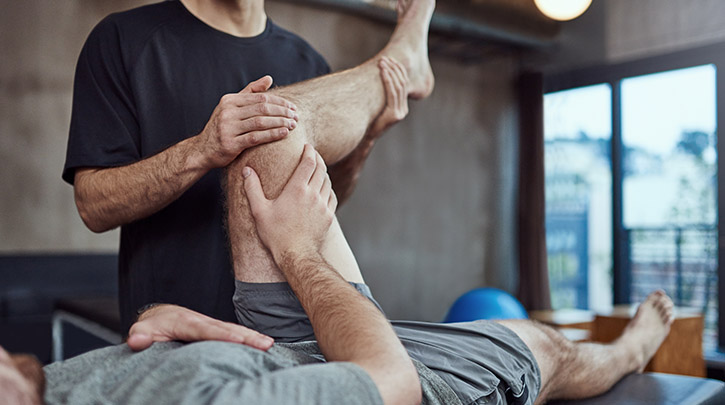
- Global
Get non-surgical solutions for today's top aesthetic concerns with Venus Treatments. Join thousands of satisfied patients worldwide!
- Loading...
- All Regions
Get non-surgical solutions for today's top aesthetic concerns with Venus Treatments. Join thousands of satisfied patients worldwide!

With summer, we often find ourselves enjoying the great outdoors, participating in seasonal sports and activities—sometimes a little more than we maybe should! Summertime soft tissue injuries like sprains and strains may be common as we tend to be more active this season, but taking the right steps to prevent and properly treat these injuries will have you enjoying a lot more time in the action, rather than watching from the sidelines.
Here, we review the top tips that soft tissue injury treatment providers share to prevent some of the most common summertime injuries and how to best treat an injury if it happens.
Without a solid foundation, you can bet your body will be set up for injury. For example, hiking may seem like just a walk on rougher terrain, but even this subtle change can increase your risk of injury if you’re not wearing the proper foot attire. In fact, wearing the wrong shoes can cause undue strain on the body, starting at the heel and traveling up the ankle to your hips, back, and neck.
To prevent soft tissue injuries while hiking (or any sport, for that matter), you need to begin with the right shoes. Arch support and a bouncy sole that offers enough rigidity for proper stability, but some shock absorption is ideal. You’ll also want to pay particular attention to the shape of the shoe around the heel and ankle. Those that cup your natural heel offer improved support, while padded ankle collars and hiking boots can offer protection for the Achilles tendon and provide ankle support on uneven terrain. In comparison, for sports that involve more running, you’ll want to opt for a lighter shoe that still offers Achilles protection but doesn’t extend so far up the ankle that you’re unable to take a proper stride. Flexibility in the sole can also better support the foot’s natural movements while running.
Gardening and golfing are two areas in which many use the wrong-sized equipment and wind up with a summer back injury. When purchasing or renting equipment, ensure the length of the handles supports proper posture and technique. Opting for something too short or too long can throw your body off-balance, putting you at risk of a soft tissue injury as your body struggles with form. For amateur golfers, having a quick lesson with a golf professional at the beginning of the year to review your golf swing, equipment choice, and proper form is an easy way to not only improve your game, but to also lower your risk of injury this summer.
Many injuries can be avoided with a proper warm-up and adequate stretching both before and after participating in a summertime activity. Many swimming injuries, for example, occur in the shoulder and may be a result of a weak core, overuse, and misuse. A quick warm-up session may include arm circles as well as some exercises to engage the core; the stronger the core, the less strain is placed on the shoulder. Further, switching up swimming and workout styles can help to limit the amount of strain focused on a particular area, allowing the body to better balance out and prevent changes in posture that could increase your risk of injury.
With summer comes lots of opportunities to get active and have a little fun with friends or family. Add to that the stress of increased hours for those who work in construction or those just trying to get ahead on office work before vacation, and your body will be craving rest. When possible, dial back the intensity and schedule in enough time between activities or work to allow your body to rest and recuperate. Ideally, when beginning a new activity or physically-demanding job, it’s safest to opt for a gradual increase in volume, intensity, and duration of about five to 10% to allow your body to get used to these new demands and build up endurance. For those working desk jobs, take a short break every hour to stretch and prevent repetitive strain injuries.
Some summertime activities may be fun but aren’t worth the risk, particularly if you think you might be prone to re-injury. Watersports like tubing or wakeboarding, for example, look extra fun, but wipeouts, waves, and bumps at high speeds can cause whiplash, strains in the back, and even sprains, depending on how hard you hit the water. Beach volleyball can also be a risky sport for those who don’t play regularly, with risk to injuring shoulder tissue or ankle sprains in the sand. While it may be fun to participate, know your limits and stick within them. Sometimes, sitting on the sidelines is actually a better move and will allow you to enjoy everything else this summer instead of taking a risk on one activity.
At-home treatment of a soft tissue injury in the acute stages (the first 24 to 72 hours post-injury) can help to improve the outcomes of in-clinic treatments. While it’s best to seek out a professional diagnosis and treatment plan for your injury to prevent anything from getting worse, you may likely be advised to start using the RICE method as an initial at-home response to better control pain, inflammation, and blood flow to the damaged tissue.
Touted as very effective by the American Academy of Orthopaedic Surgeons(AAOS), the RICE method recommends rest, ice, compression, and elevation for treating certain soft tissue injuries. Alternatively, your treatment provider may suggest a variation of this method, called MICE—movement, ice, compression, and elevation—to gently stretch and exercise range of motion without applying weight or strain to the injured tissue. If you’re unsure which method to follow, ask your treatment provider or family physician for their recommendation over the phone. While they might not be able to offer comprehensive recommendations without first diagnosing your injury, they should be able to recommend methods for treating pain and inflammation in the meantime. However, there are four things you should typically stay away from during this time: heat, alcohol, running, and massage. While these therapies may assist in the reparation and rehabilitation phases, they can cause further damage if used during the acute injury phase.
Once you’re at your appointment, your treatment provider may consider a host of different soft tissue injury treatment technologies. One promising treatment, in particular, taps into three different therapeutic treatment modes, each with their own proven and powerful benefits for effectively targeting soft tissue injuries, and combines them into one powerful treatment that offers quicker healing and improved results, compared to more traditional therapies. Quick 10-minute Venus Heal™ treatments are the first of their kind to deliver deep and targeted tissue heating, pulsed magnetic energy, and massage to damaged tissue, all in one treatment. Pain relief, increased local blood circulation, and improvements in inflammation, muscle tension, and range of motion all speed up recovery, helping you to get back to enjoying your summer in less time than is possible with conventional treatment methods alone. Use these treatments on their own or as part of a holistic treatment plan and get back to feeling your best.
Interested in learning more or experiencing the benefits of Venus Heal™ soft tissue injury treatments for yourself? Locate a local provider near you using the search field below.
Find a certified Venus Treatments provider near you today who specializes in today’s top aesthetic medical solutions.



Search below to find a provider near you and to learn about our non-surgical aesthetic treatments with ARTAS®, NeoGraft®, Venus Bliss™, Venus Blilss MAX™, Venus Versa™, Venus Legacy™ Venus Versa™ Pro, Venus Velocity™, Venus Viva™ MD, and Venus Glow™.
For more information call: (888) 907-0115 // [email protected] // 235 Yorkland Blvd., Suite 900, Toronto, ON, M2J 4Y8 Canada
REGULATORY CLEARANCES [ More ]
Venus Bliss™ is cleared by the FDA and licensed by Health Canada for non-invasive lipolysis of the abdomen and flanks in individuals with a Body Mass Index (BMI) of 30 or less, with the diode laser applicators. The (MP)2 applicator is cleared by the FDA for temporary reduction in the appearance of cellulite, and licensed by Health Canada for temporary increase of skin tightening, temporary circumferential reduction, and temporary cellulite reduction. Venus Bliss™ has CE Mark as a non-invasive medical aesthetic device enabling a comprehensive approach leading to body contouring, addressing fat reduction, skin tightening, circumference reduction, and cellulite reduction.
Venus Versa™ is cleared by the FDA, licensed by Health Canada, and has CE Mark as a multi-application device intended to be used in aesthetic and cosmetic procedures. The SR515 and SR580 applicators are cleared by the FDA, licensed by Health Canada, and have CE Mark for the treatment of benign pigmented epidermal and cutaneous lesions and treatment of benign cutaneous vascular lesions. The HR650/HR650XL and HR690/HR690XL applicators are cleared by the FDA, licensed by Health Canada, and have CE Mark for the removal of unwanted hair and to effect stable long-term or permanent hair reduction for Fitzpatrick skin types I-IV. The AC Dual applicator is cleared by the FDA, licensed by Health Canada, and has CE Mark for the treatment of acne vulgaris. The DiamondPolar™ and OctiPolar™ applicators on the Venus Versa™ system are cleared by the FDA for non-invasive treatment of moderate to severe facial wrinkles and rhytides on females with Fitzpatrick skin types I-IV. The DiamondPolar™ applicator is licensed by Health Canada and has CE Mark for non-invasive treatment of moderate to severe facial wrinkles and rhytides on females with Fitzpatrick skin types I-IV. The OctiPolar™ applicator on the Venus Versa™ system is licensed by Health Canada and has CE Mark for temporary body contouring via skin tightening, circumferential reduction, and cellulite reduction. The NanoFractional RF™ (Viva) applicator is cleared by the FDA, licensed by Health Canada, and has CE Mark for dermatological procedures requiring ablation and resurfacing of the skin.
NeoGraft® is cleared by the FDA, licensed by Health Canada and has CE Mark with indication for use in suction-assisted follicular extraction and re-implantation. It is an auto-graft system and can be used on both male and female patients.
ARTAS iX™ is cleared by the FDA, licensed by Health Canada and has CE Mark with indication for use for harvesting hair follicles from the scalp in men diagnosed with androgenic alopecia (male pattern hair loss) who have black or brown straight hair. ARTAS iX™ is intended to assist physicians in identifying and extracting hair follicular units from the scalp during hair transplantation; creating recipient sites; and implanting harvested hair follicles.
Venus Legacy™ is cleared by the FDA for the non-invasive treatment of moderate to severe facial wrinkles and rhytides in females with Fitzpatrick skin types I-IV with the OctiPolar™ and DiamondPolar™ applicators, and temporary reduction in the appearance of cellulite with the 4D Body (LB2) and 4D Face (LF2) applicators. It is licensed by Health Canada and has CE Mark for the temporary increase of skin tightening, temporary circumferential reduction, temporary cellulite reduction, and temporary wrinkle reduction.
Venus Velocity™ is cleared by the FDA, licensed by Health Canada and has CE Mark for hair removal, permanent hair reduction (defined as the long-term stable reduction in the number of hairs re-growing when measured at 6, 9 and 12 months after the completion of a treatment regimen), and the treatment of pseudofolliculitis barbae for all Fitzpatrick skin types.
Venus Fiore™ received regulatory approval in Israel for aesthetic and functional treatment of the vagina, labia and mons pubis. Venus Fiore™ is available for sale in India, Hong Kong, and other selected Asian countries.
Venus Viva™ is cleared by the FDA, licensed by Health Canada, and has CE Mark for dermatological procedures requiring ablation and resurfacing of the skin. The DiamondPolar™ applicator is cleared by the FDA, licensed by Health Canada and has CE Mark for the treatment of moderate to severe wrinkles and rhytides in Fitzpatrick skin types I-IV.
Venus Freeze Plus™ is cleared by the FDA for the non-invasive treatment of moderate to severe facial wrinkles and rhytides in females with Fitzpatrick skin types I-IV. It is licensed by Health Canada for temporary skin tightening, and temporary reduction in the appearance of cellulite on the abdomen and flanks, using the DiamondPolar™ and OctiPolar™ applicators. The DiamondPolar™ applicator on Venus Freeze Plus™ has CE Mark for the non-invasive treatment of moderate to severe facial wrinkles and rhytides, and the increase of skin tightening, temporary circumferential reduction, and cellulite reduction with the OctiPolar™ applicator.
Venus Heal™ is licensed by Health Canada and can be used for the treatment of both acute and chronic disorders of the musculoskeletal system, such as muscle spasms, back pain, and soft tissue injuries, and results in effects such as pain relief, myorelaxation, increase of local blood circulation, and edema reduction. In the U.S., Venus Heal™ is cleared by the FDA for the relief of minor muscle aches and pain, relief of muscle spasm, and temporary improvement of local blood circulation. These indications enable the treatment of certain soft tissue injuries and conditions.
Venus Glow™ is cleared by the FDA as a Class I motorized dermabrasion device. It provides a dermal rejuvenation treatment that works to open up and deep-clean pores. Venus Concept is the exclusive distributor for Venus Glow™.
Venus Epileve™ is licensed by Health Canada and has CE Mark for hair removal, permanent hair reduction (defined as the long-term stable reduction in the number of hairs re-growing when measured at 6, 9 and 12 months after the completion of a treatment regimen), and the treatment of pseudofolliculitis barbae for all Fitzpatrick skin types. Venus Epileve™ is also CE-Marked for hirsutism.
Venus Freeze™ is cleared by the FDA for the non-invasive treatment of moderate to severe facial wrinkles and rhytides in females with Fitzpatrick skin types I-IV. It is licensed by Health Canada for temporary skin tightening, and temporary reduction in the appearance of cellulite on the abdomen and flanks, using the DiamondPolar™ and OctiPolar™ applicators. The DiamondPolar™ applicator on Venus Freeze™ has CE Mark for the non-invasive treatment of moderate to severe facial wrinkles and rhytides, and the increase of skin tightening, temporary circumferential reduction, and cellulite reduction with the OctiPolar™ applicator.
Venus Swan™ is cleared by the FDA for the non-invasive treatment of moderate to severe facial wrinkles and rhytides, and licensed by Health Canada for the non-invasive treatment of cellulite reduction, skin tightening, and temporary reduction in the appearance of stretch marks.
Copyright © 2024 Venus Concept. All rights reserved.
You are entering our website. For other countries/regions and language options, please click the SELECT A DIFFERENT REGION button below.
SELECT A DIFFERENT REGIONAre you looking to get a treatment? Please visit our patient website to learn more.
Click HereUnsure which aesthetic treatment is right for you? Take this quick and easy quiz to discover treatments that suit your needs.
Get Started